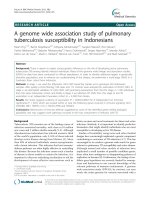97 ways to make a baby laugh
Bạn đang xem bản rút gọn của tài liệu. Xem và tải ngay bản đầy đủ của tài liệu tại đây (3.16 MB, 187 trang )
WORKMAN PUBLISHING • NEW YORK
The process of publishing this book began with a
one-page letter to Workman Publishing Company,
containing a suggested title and a proposed format.
I was fortunate. Peter Workman took my letter from
a giant pile of unsolicited book proposals and
placed it in a much smaller pile while personally
responding that I had a “good concept and title” but
he would have to see much more.
Several months later I submitted what I felt was
the finished product. The book was assigned to
Ruth Sullivan, my editor, for what I believed were
minor corrections and polishing. Ms. Sullivan did
not agree, but rather saw my work as a skeleton of
what the book could and should be. Her candor,
suggestions for changing content and format, and
demanding professionalism made this book so
much more than it was in its infancy, and to Ms.
Sullivan I am sincerely thankful.
I would also like to extend thanks to my dear
friends Bruce Ender and Laurie Mahan for their
assistance, and to the Smith family for their
encouragement and support.
Bring a baby to any grown-up—even the gruffest
or most inhibited—and watch what happens.
Without exception, they will do something to try
and make the baby laugh. Psychologists,
anthropologists and other experts have theories
about why this is so. For me it’s enough to believe
that whenever a baby laughs, our humanity is
somehow exalted. That is why I wrote this book.
A baby’s laughter is infectious and addictive.
Once you get that first little giggle, you’ll do just
about anything to re-create it. But it helps to have a
whole repertoire of tricks. Here are 97 very silly,
sometimes stupid, but effective ways to make a
baby laugh—including sight gags, Laurel & Hardy
routines, and parlor tricks. Most are originals
developed over several years and tried out on
countless babies; some are classics with a unique
twist that can make the difference between a smile
and a belly laugh. Among the infant-tested formulas
are The Top Ten Peek-a-Boos, The Googly Face
Contest, The Live Jack-in-the-Box and that old
standby, The Raspberry.
I’ve found that all babies will laugh at some of
these skits and some babies will laugh at all of
them. It’s a matter of taste. Some babies delight in
repetition, such as dropping an object from a high
chair and having it repeatedly retrieved by Mom or
Dad; others relish the unexpected, such as seeing
their favorite stuffed animal transported into the
room by a remote-control truck. What tickles one
baby’s funny bone may puzzle or even annoy
another.
You will learn by trial and error what works
best for your baby. The exercises in this book are
geared for babies age three months (when babies
first begin to have a sense of humor) to fourteen
months (when their increased mobility makes them
less than a captive audience). Babies as young as
six months begin to appreciate incongruities. In
fact, they adore them. Seeing Grandma’s glasses on
top of her head or the dog wearing a baby bonnet is
cause for great hilarity. Or attach that rubber
suction toy Baby is used to seeing on his high chair
tray to your forehead and you’re guaranteed a
laugh.
Though the primary purpose of this book was to
make babies laugh, a funny and wonderful thing
happened along the way. As I experimented by
having friends and relatives perform for Baby,
even the most reserved would lose their inhibitions
and become as goofy as their roles required. When
Baby laughed, the show was a smash. But when
Baby would give a deadpan reaction, the scene
was often even funnier: a roomful of adults
laughing hysterically at their failed attempts to
make a baby laugh. Performing routines from this
little book is a great way to relieve the tension and
stress of life with an infant. So lighten up,
rediscover your sense of the absurd, and life with
Baby will be that much more fun.
family sing the familiar tune Pop Goes the Weasel.
When you get to the last line, Dad jumps out of the
box.
mouth and have him suck it in as quickly as
possible.
Note: For best results, I prefer capellini done al dente,
but I have friends who swear by linguine.
“Ah-Ah-Ah-Ah-Choo!”
Have family members compete for Baby’s
attention. Whoever gets the biggest laugh is
declared the winner.
Note: No props permitted in this one. Here’s your chance
to take advantage of that walleye, big nose, flexible
tongue, wiggling eyebrows or any other fancy trick
you’ve developed through the years.
improvisational, nonrepetitive break dance.
Note: Everyone else in the room should clap and repeat
the beat, “Go girl! Go girl!”
agile members of the family lift a soccer ball from
the floor using nothing but their heads.
EQUIPMENT: Soccer ball, floor padding
PHYSICAL MODEL: Irreproducible
RISK TO PARENT: High
RESULTS: Inverse ratio of parent’s success to success
with Baby
Granted, the original story of pigs going to market
is completely lost on Baby, but the line “Wee Wee
Wee all the way home” rarely fails to bring on
peals of laughter.
eyes. Remove hands and say “Pee-ee-k.” A
favorite version is to have Mom hide her head
beneath a blanket and pop out at Baby with a
“Boo.”
Note: If Baby’s response is deadpan, perhaps she’s too
sophisticated for basic peek-a-boo. See Advanced Peek-
a-Boo, No. 70.









